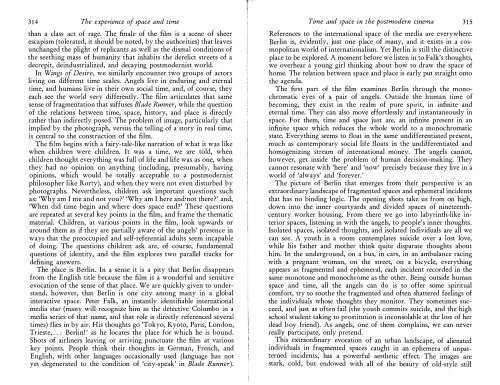The Condition of Postmodernity 13 - autonomous learning
The Condition of Postmodernity 13 - autonomous learning
The Condition of Postmodernity 13 - autonomous learning
Create successful ePaper yourself
Turn your PDF publications into a flip-book with our unique Google optimized e-Paper software.
314 <strong>The</strong> experience <strong>of</strong> space and timethan a class act <strong>of</strong> rage. <strong>The</strong> finale <strong>of</strong> the film is a scene <strong>of</strong> sheerescapism (tolerated, it should be noted, by the authorities) that leavesunchanged the plight <strong>of</strong> replicants as well as the dismal conditions <strong>of</strong>the seething mass <strong>of</strong> humanity that inhabits the derelict streets <strong>of</strong> adecrepit, deindustrialized, and decaying postmodernist world.In Wings <strong>of</strong> Desire, we similarly encounter two groups <strong>of</strong> actorsliving on different time scales. Angels live in enduring and eternaltime, and humans live in their own social time, and, <strong>of</strong> course, theyeach see the world very differently. <strong>The</strong> film articulates that samesense <strong>of</strong> fragmentation that suffuses Blade Runner, while the question<strong>of</strong> the relations between time, space, history, and place is directlyrather than indirectly posed. <strong>The</strong> problem <strong>of</strong> image, particularly thatimplied by the photograph, versus the telling <strong>of</strong> a story in real time,is central to the construction <strong>of</strong> the film.<strong>The</strong> film begins with a fairy-tale-like narration <strong>of</strong> what it was likewhen children were children. It was a time, we are told, whenchildren thought everything was full <strong>of</strong> life and life was as one, whenthey had no opinion on anything (including, presumably, havingopinions, which would be totally acceptable to a postmodernistphilosopher like Rorty), and when they were not even disturbed byphotographs. Nevertheless, children ask important questions suchas: 'Why am I me and not you?' 'Why am I here and not there?' and,'When did time begin and where does space end?' <strong>The</strong>se questionsare repeated at several key points in the film, and frame the thematicmateriaL Children, at various points in the film, look upwards oraround them as if they are partially aware <strong>of</strong> the angels' presence inways that the preoccupied and self-referential adults seem incapable<strong>of</strong> doing. <strong>The</strong> questions children ask are, <strong>of</strong> course, fundamentalquestions <strong>of</strong> identity, and the film explores two parallel tracks fordefining answers.<strong>The</strong> place is Berlin. In a sense it is a pity that Berlin disappearsfrom the English title because the film is a wonderful and sensitiveevocation <strong>of</strong> the sense <strong>of</strong> that place. We are quickly given to understand,however, that Berlin is one city among many in a globalinteractive space. Peter Falk, an instantly identifiable internationalmedia star (many will recognize him as the detective Columbo in amedia series <strong>of</strong> that name, and that role is directly referenced severaltimes) flies in by air. His thoughts go 'Tokyo, Kyoto, Paris, London,Trieste, . .. ' Berlin!' as he locates the place for which he is bound.Shots o-{· airliners leaving or arriving punctuate the film at variouskey points. People think their thoughts in German, French, andEnglish, with other languages occasionally used (language has notyet degenerated to the condition <strong>of</strong> 'city-speak' in Blade Runner).Time and space in the postmodern cinema 315References to the international space <strong>of</strong> the media are everywhere.Berlin is, evidently, just one place <strong>of</strong> many, and it exists in a cosmopolitanworld <strong>of</strong> internationalism. Yet Berlin is still the distinctiveplace to be explored. A moment before we listen in to Falk's thoughts,we overhear a young girl thinking about how to draw the space <strong>of</strong>home. <strong>The</strong> relation between space and place is early put straight ontothe agenda.<strong>The</strong> first part <strong>of</strong> the film examines Berlin through the monochromaticeyes <strong>of</strong> a pair <strong>of</strong> angels. Outside the human time <strong>of</strong>becoming, they exist in the realm <strong>of</strong> pure spirit, in infinite andeternal time. <strong>The</strong>y can also move effortlessly and instantaneously inspace. For them, time and space just are, an infinite present in aninfinite space which reduces the whole world to a monochromaticstate. Everything seems to float in the same undifferentiated present,much as contemporary social life floats in the undifferentiated andhomogenizing stream <strong>of</strong> international money. <strong>The</strong> angels cannot,however, get inside the problem <strong>of</strong> human decision-making. <strong>The</strong>ycannot resonate with 'here' and 'now' precisely because they live in aworld <strong>of</strong> 'always' and 'forever.'<strong>The</strong> picture <strong>of</strong> Berlin that emerges from their perspective is anextraordinary landscape <strong>of</strong> fragmented spaces and ephemeral incidentsthat has no binding logic. <strong>The</strong> opening shots take us from on high,down into the inner courtyards and divided spaces <strong>of</strong> nineteenthcenturyworker housing. From there we go into labyrinth-like interiorspaces, listening in with the angels, to people's inner thoughts.Isolated spaces, isolated thoughts, and isolated individuals are all wecan see. A youth in a room contemplates suicide over a lost love,while his father and mother think quite disparate thoughts abouthim. In the underground, on a bus, in cars, in an ambulance racingwith a pregnant woman, on the street, on a bicycle, everythingappears as fragmented and ephemeral, each incident recorded in thesame monotone and monochrome as the other. Being outside humanspace and time, all the angels can do is to <strong>of</strong>fer some spiritualcomfort, try to soothe the fragmented and <strong>of</strong>ten shattered feelings <strong>of</strong>the individuals whose thoughts they monitor. <strong>The</strong>y sometimes succeed,and just as <strong>of</strong>ten fail (the youth commits suicide, and the highschool student taking to prostitution is inconsolable at the loss <strong>of</strong> herdead boy friend). As angels, one <strong>of</strong> them complains, we can neverreally participate, only pretend.This extraordinary evocation <strong>of</strong> an urban landscape, <strong>of</strong> alienatedindividuals in fragmented spaces caught in an ephemera <strong>of</strong> unpatternedincidents, has a powerful aesthetic effect. <strong>The</strong> images arestark, cold, but endowed with all <strong>of</strong> the beauty <strong>of</strong> old-style still
















